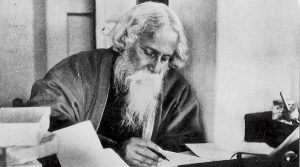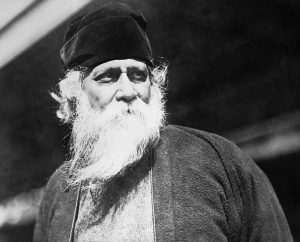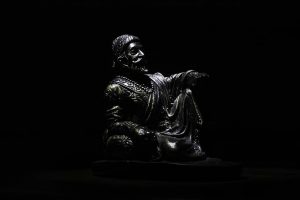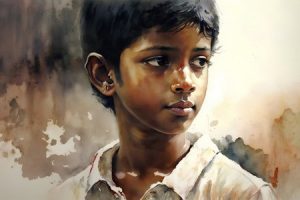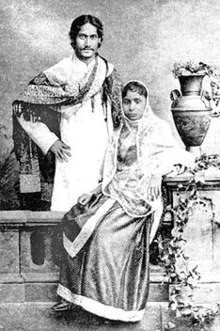
According to Rabindranath Tagore’s nephew Abanindranath, Rabi Kaka wasn’t particularly eager to get betrothed. Primarily due to family expectations, he agreed to the arrangements made by matriarch Adyasundari (মামা ব্রজেন্দ্রনাথ রায়ের পিসিমা আদ্যাসুন্দরী।) Rabindranath’s two elder sisters, Jnanadanandini and Kadambini, brother Jyotirindranath, younger brother Surendranath, and he himself went to Jessore to fix an alliance with the daughter of Benimadhav Roychowdhury. The Tagore estate employee’s daughter Bhabatarini was only 9 when her marriage to 22-year-old Rabindranath was settled to be held on December 9, 1883.
Unfortunately, the wedding took place hastily, coinciding with an inauspicious incident, since Rabindranath’s sister Saudamini Devi’s husband, Saradaprasad Gangopadhyay, passed away on the same day. At the centre of the Tagore family was Maharshi Debendranath, following whose instructions, the bride’s family came to Maharshi Bhavan, Jorasanko, for the event. Hemlata Tagore, the wife of Dwijendranath Tagore, vividly describes the wedding and early days of married life between Mrinalini (Bhabatarini) and Rabindranath. Unlike others, this marriage was simple and devoid of any extravagance. As per the customs of the Tagore family, a ceremonial Banarasi shawl was to be draped by the groom. Taking a stroll around the western veranda of the Jorasanko, Tagore arrived at the wedding chamber as if he had travelled a long distance before finally meeting the bride.
Bhabatarini had completed primary education in her village. Later on, she was trained and mentored according to the Tagore family traditions. Eventually, Bhabatarini became Mrinalini, a name given by Tagore, which many speculate may have drawn inspiration from Nalini, an endearing name Tagore had given to Anna Turkhad, his alleged first love.
Descriptions of her reveal Mrinalini possessed, without any pretentiousness, a captivating yet subdued charm. She was most likely deeper complexioned. Urmila Devi, daughter-in-law of Tagore household, had mentioned that the daughters of Jorasanko “…দুধ দিয়ে স্নান করেন, ক্ষীর সর ছানা বেটে রূপটান মাখেন—কত গয়না, কত কাপড় যে শরীরে পরেন তার ঠিক নেই।’’ (“bathe in milk, their bodies adorned with fragrant sandalwood, draped in countless garments—a sight beyond words”). Amidst these celestial nymphs, Mrinalini was “not visually pleasing.” Although later Urmila Devi observed, “এক অপরূপ লাবণ্যে সমস্ত মুখখানা যেন ঢলঢল করছে, আর একটা মাতৃত্বের আভায় যেন মুখখানা উজ্জ্বল। একবার দেখলে আবার দেখতে ইচ্ছে হয়।’’(“As if an extraordinary allure emanates from her countenance, and a subtle essence of motherhood illuminates her. One glimpse of her beckons a desire to see her again.”)
As for Tagore’s impression of Chhuti (ছুটি) Mrinalini, she believed, Tagore only confided in women he favoured, the ones who shared similar intellect as him. Among these individuals were নতুন বৌঠান (sister-in-law Kadambari Devi), and niece Indira Devi, who had a deep understanding of the poet’s mind. The letters Tagore had written to her are contained in the renowned epistolary literature, “Chinnapatra”. Perhaps Mrinalini Devi felt overshadowed by these accomplished women as she once asked why couldn’t they communicate the same way. To which Tagore replied:
“তুমি মোরে পারনা বুঝিতে?
…যাহা আছে সব আছে তোমার আঁখির কাছে|” (“Can you not understand me?… All that exists is within the reach of your eyes.”)
This was reciprocated by Mrinalini in various instances as she stood behind him, supporting his cause. Be it hosting dinners for his friends or assisting in the construction of Santiniketan by selling her personal gold ornaments, her commitment remained steadfast, playing a vital role in their shared journey.
During her final hours in 1902, Tagore sat all night, fanning her. He sang to her “আজি ঝড়ের রাতে তোমার অভিসারে” (“Tonight amid the storm, in the embrace of your departure”) in a whimsical trance. By the end, Chhuti (ছুটি) had found her forever respite marking an end to their 19-year-relationship. These 19 years gave Tagore five children, and many intimate and fond memories which he cherished throughout his life.


